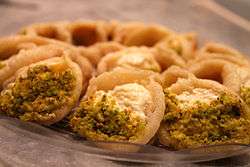Qatayef
Qatayef or Katayef (Arabic: قطايف, [qā'ṭā:īf] (![]()
 | |
| Type | Dumpling |
|---|---|
| Place of origin | Levant, Middle East |
| Region or state | Egypt, Iraq, Jordan, Lebanon, Israel, Palestine, Saudi Arabia and Syria |
| Main ingredients | unsalted cheese, or a mixture of hazelnuts, walnuts, almonds, pistachios, raisins, powdered sugar, vanilla extract, and cinnamon |
Etymology
The Arabic word Qatayef (Arabic: قطايف) is derived from the Arabic root qtf, meaning to pick up or to pluck[2][3]
Origin and history
Qatayef is believed of Fatimid origin.[4] Some believe that Qatayef are the creation of the Fatimid Dynasty, however, their history dates back to the Abbasid Caliphate, 750-1258 CE.[5][6] Qatayef was mentioned in a tenth century Arabic cookbook dates back to the Abbasid Caliphate by Ibn Sayyar al-Warraq called Kitab al-Ṭabīḫ (Arabic: كتاب الطبيخ, The Book of Dishes).[7] The book was later translated by Nawal Nasrallah, and named it (Annals of the Caliphs' Kitchens).[8] Qatayef was traditionally prepared by street vendors as well as households in the Levant and Egypt. It is usually prepared using Akkawi cheese as a filling.[9][10]
Preparation
Qatayef is the general name of the dessert as a whole, but more specifically, the batter. It is usually made out of flour, baking powder, water, yeast, and sometimes sugar is added. The result of the batter being poured onto a round hot plate appears similar to pancakes, except only one side is cooked, then stuffed and folded. The pastry is filled with either unsalted sweet cheese a mixture of any of hazelnuts, walnuts, almonds, pistachios, raisins, powdered sugar, vanilla extract, roses extract (ma-zahr ماء الزهر) and cinnamon. It is then deep-fried or, less commonly, baked and served with a hot sweet syrup or sometimes honey. Another way of serving Qatayef is by filling it with whipped cream or Qishta (قشطة) clotted cream, folded half way and served with scented syrup without any frying or baking. This way of serving is called Assafiri Qatayef (قطايف عصافيري). [11][12]
References
- "Qayatef (Katayef) Recipe; folded pancakes with nuts". Amira's Pantry. 2019-05-05. Retrieved 2019-06-11.
- Freytag, Georg (1830). Lexicon Arabico-Latinum praesertim ex Djeuharii Firuzabadiique et aliorum Arabum operibus, adhibitis Golii quoque et aliorum libris, confectum (Vol.1 ed.). C. A. Schwetschke et filium. p. 468.
- Badawi, Al-Saïd; Abdel-Haleem, Muhammad. Arabic - English Dictionary of Qurʾanic Usage. BRILL. p. 767.
- "The Ramadan Experience in Egypt". Archived from the original on 2019-05-07. Retrieved 2018-06-18.
- life, style. "The sweet history of Qatayef". Roya news. Retrieved 26 August 2018.
- 1, 2. "In Gaza, Qatayef tradition thrives during Ramadan". GULF NEWS. Retrieved 26 August 2018.CS1 maint: numeric names: authors list (link)
- al-Warrāq, Ibn Sayyār; Nasrallah, Nawal (Nov 26, 2007). Annals of the Caliphs' Kitchens: Ibn Sayyār Al-Warrāq's Tenth-century Baghdadi Cookbook. BRILL. p. 422. Retrieved 30 August 2018.
- al-Warrāq, Ibn Sayyār; Nasrallah, Nawal. "Annals of the Caliphs' Kitchens: Ibn Sayyār Al-Warrāq's Tenth-century Baghdadi Cookbook". books. Retrieved 30 August 2018.
- Sadat, Jehan (2002). A Woman of Egypt. Simon & Schuster. p. 48.
- Abu-Zahra, Nadia (1999). The Pure and Powerful: Studies in Contemporary Muslim Society. Ithaca Press. ISBN 9780863722691.
- "Qatayef with nuts قطايف بالمكسرات | Egyptian Cuisine and Recipes". egyptian-cuisine-recipes.com. Retrieved 2018-03-14.
- Katayef (Ramadan pancakes) Archived 2011-07-24 at the Wayback Machine This Week in Palestine, Turbo Computers & Software Co. Ltd. 2007-07-09 Accessed on 2008-01-07.